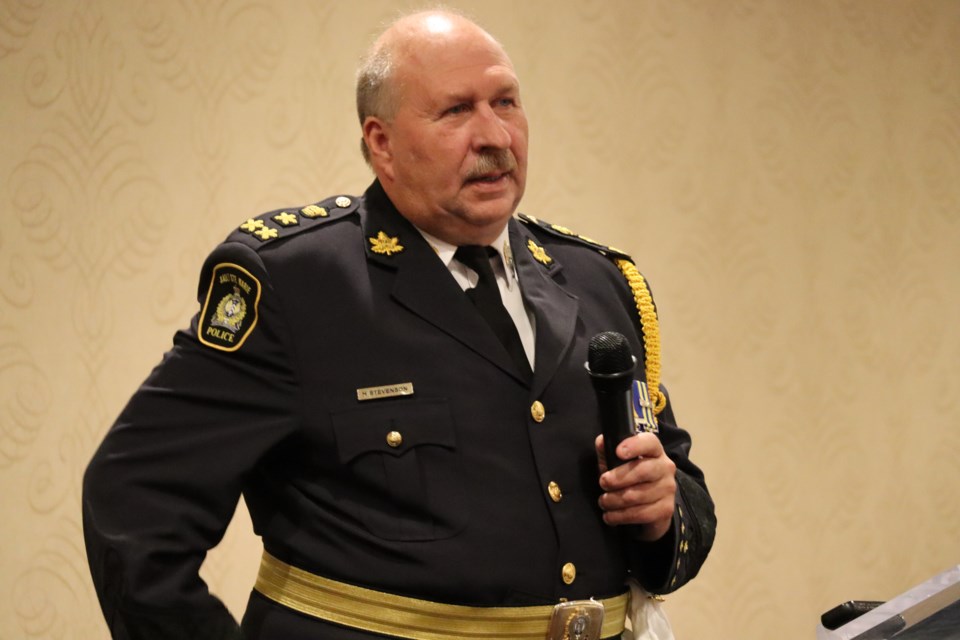Sault Police has scaled back a proposed 13.5 per cent increase to its 2024 budget down to an increase of 9.8 per cent — or roughly $3.4 million more than last year's budget of $33.8 million — in order to support the creation of a downtown division, an increase in civilian staff and the acquisition of enhanced technology.
But the downsized ask for this year’s police budget didn’t stop members of city council from peppering Sault Ste. Marie Police Service Chief Hugh Stevenson with a multitude of questions about the proposed expenditures during Monday night’s council meeting.
Stevenson told city council the increase to police spending comes at a time when incidents of violent crime have climbed by 80 per cent and calls to 911 have doubled over the past five years.
The proposed increase would represent a 6.4 per cent jump in the police service’s base budget, with another 3.4 per cent increase proposed to support expansion into the downtown core with a fully supported division, in addition to the implementation of body-worn cameras, digitally enhanced tasers, digital evidence management and cloud support.
Stevenson said body-worn cameras will make for quicker resolution of complaints, alleviate pressure on its Professional Standards Bureau and reduce legal costs by 30 per cent. An average of roughly $150,000 is spent each year on legal matters involving police.
“But the real cost here isn’t necessarily the savings from legal, it’s the amount of time and energy it costs us to investigate complaints,” Stevenson said.
Under the scaled-back proposal, the police service would hire four full-time officers on top of the 17 officers it wants to add in order to create a downtown division. All officers would be hired over a three-year period under the proposed budget, Stevenson said, with seven officers being hired each year in an effort to reduce the cost to the municipality.
The total spend on capital costs and the 17 officers for a downtown division would equal a $3.6-million commitment over three or four years. The cost would also include the acquisition of a facility downtown to support the division. “It’s an expensive venture,” the police chief told council members.
The hiring of four civilian full-time employees for 911 dispatch and four civilian full-time employees for the management of digital evidence, including video from body-worn cameras, is also part of the proposed increase to the budget.
Stevenson said the purpose behind the proposed increases to staff is to mitigate increasing overtime costs and sick pay, to stay ahead of forecasted retirements and to police the community more effectively in light of more complicated — and violent — calls for service.
Currently, 12.68 per cent of officers are on leave, the police chief added, with another 5.6 per cent of officers being “accommodated and non-frontline.”
Stevenson told council that as of right now, anywhere from six to eight police officers are working during a shift.
“There’s actually 13 in the platoon. But for a variety of reasons, they’re not coming to work, and I can’t help that,” he said.
Sick time has increased nearly 19 per cent year-to-date over the same period last year. Officers are also turning down overtime shifts due to burnout.
“It’s a rolling ball. If we don’t hire staff, we’re continually burning out the people we have,” Stevenson added.
The chief of police also expressed concern about a looming staff shortage due to retirement. Four officers and four civilian employees are eligible to retire in 2023. An additional 13 officers and another four civilian employees will be in a position to retire by 2024 or early 2025.
Stevenson's Monday evening presentation to city council lasted about an hour-and-a-half in total, with members of council taking turns hammering the police chief with pointed questions on the propose police spending for 2024.
Ward 2 Coun. Luke Dufour asked if the Sault Ste. Marie Police Services Board has considered producing a multi-year operational budget for the sake of clarity, as the councillor felt he was receiving budget details in “bits and pieces.”
“If we’re talking about building out a division that’s going to last multiple years, it would be really nice to see just a little bit more of a fleshed-out budget and forecast a strategic direction for those investments,” Dufour said.
Mayor Matthew Shoemaker asked Sault Ste. Marie Police Service to spread out its proposed budget over four years as opposed to three.
“It’s just a matter of how we best balance that against other considerations,” he told Stevenson.
A report on potential “synergies” between the police service and city staff is anticipated sometime in the new year, said chief administrative officer Malcolm White, but any recommendations stemming from that report related to cost-saving measures wouldn’t be implemented until 2025.
Ward 5 Coun. Corey Gardi was of the opinion that governments have to be clear on the “significant crisis as it relates to financial resources” and the ability for municipalities to be able to maintain their police services going forward.
“I want to say one thing: every violent crime that we’ve had this year has something to do with the poison coming into this community,” Stevenson said in response. “There’s an angle of poison in every one of these calls, and it involves violence and guns and death — and that is very devastating to this community.”
City council will begin 2024 budget deliberations Dec. 11.
